| INTERNATIONAL STANDARD |
ISO Approved Work Item No 22009 WORKING DRAFT |
|
A2. Nonstationary Case. Case study for January 9-12, 1997 The dynamics of the magnetospheric current systems was studied in [Alexeev et al., 2001] in terms of A99 model for the specific magnetospheric disturbance on January 9-12, 1997 caused by the interaction of the Earth's magnetosphere with a dense solar wind plasma cloud. A dense cloud of the solar wind plasma was of rather complicated structure. A southward interplanetary magnetic field (IMF) in its leading part caused a significant substorm activity during the interaction with the magnetosphere. A strong increase of the relativistic electron fluxes at the geosynchronous orbit was observed [Reeves et al., 1998]. The trailing half of the magnetic cloud contained a strong northward IMF and was accompanied by a large density enhancement that strongly compressed the magnetosphere. Because of the significant compression of the magnetosphere, several magnetopause crossings by the geostationary orbit took place. This storm causes also the crash of geostationary satellite Telstar 401 leading to significant financial losses. Figure 11 shows the Dst and AL indices (Figures 11a and 11b). The hourly averaged Wind data on the plasma and magnetic field are presented in Figures 11c-11e. The time delay ( ~ 25 min) between the measurements in the Earth's vicinity and on board the Wind spacecraft is taken into account.
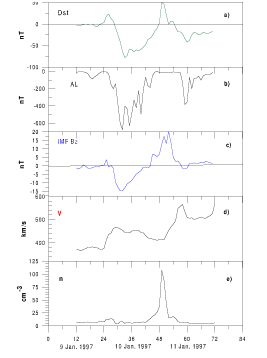
The model input parameters were defined by the solar wind density and velocity, by the strength and direction of the interplanetary magnetic field, and by the auroral AL index. Figure 12 presents the time variations of the model input parameters: the tilt angle (Figure 12a) and the magnetic field flux across the magnetotail lobes (Figure 12b). Figure 12c shows br, calculated using Burton equation and Dessler-Parker-Skopke equation. Figure 12d shows the distances to the magnetopause subsolar point and to the earthward edge of the tail current sheet.
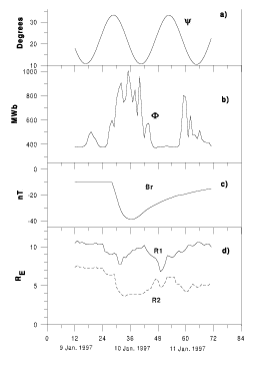
To investigate the Dst sources during the January 9-12, 1997, event the ground magnetic field was analyzed in terms of the paraboloid model of the magnetosphere A99, which allows us to distinguish the contributions of different large-scale current systems. The paraboloid model calculations are demonstrated in Figure 13 at the left panel. The magnetospheric magnetic field variation is calculated at the geomagnetic equator at each hour of magnetic local time (MLT) and averaged over the equator. Figures 13a-13c (left panel) present the Dst sources Bcf, Br, and Bt and their parts arising owing to the Earth currents. Figure 13d compares the Dst and the calculated magnetic field. A good agreement is obtained for both the relatively quiet and disturbed periods. The calculations in terms of the paraboloid model give an RMS deviation from Dst (dB) of ~ 8.7 nT. 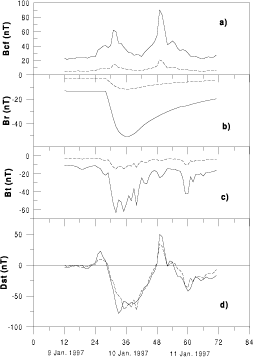
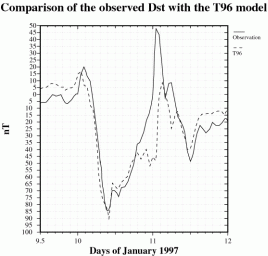
We can see from the analysis of magnetic storm on January 9-12, 1997, that the magnetospheric dynamics depends on all the magnetospheric magnetic field sources, which appear to be comparable by the order of magnitude. The paraboloid model can be successfully applied, especially in the disturbed periods, when the empirical models are often not valid. The same magnetic storm was investigated by [Turner et al., 2000] in terms of T96 model. The important feature of the T96 model is (as reported by the author in the T96_01 model's description) its applicability only for 20 nT > Dst > -100 nT, 0.5 nPa < psw < 10 nPa, and -10 nT < BzIMF < 10 nT. In the course of the storm under consideration (January 9-12, 1997) the upper value of psw is significantly beyond the 10 nPa limit. During the most disturbed interval of the magnetic storm under consideration (the first hours of 11 January 1997) T96 model was out of order (see Figure 13, right panel). The Figure 13 right panel represents calculations made by T96 model in [Turner et al., 2000]. The reason for the residual difference between the calculations presented in [Alexeev et al., 2001] and those made by Turner et al. [2000] was investigated in [Alexeev et al., 2001]. This is the tail current inner edge dynamics which are taken into account in the paraboloid model in accordance with the auroral oval expansion due to the substorm activity. In the calculations made by Turner et al. [2000] the dynamics of the inner edge of the tail current sheet are neglected.
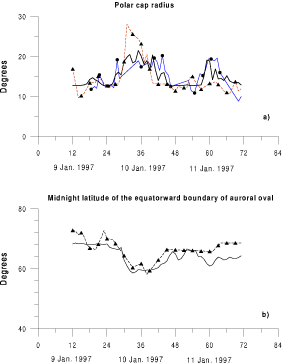
Thus the discrepancy of the results obtained in [Alexeev et al., 2001] and in that of Turner et al. [2000] is explained mainly by the use of different quantitative models and associated with the difference of the tail current parameterization. The quality of a model and its flexibility are defined by the possibility of reflecting the dynamics of the large-scale current systems. The empirical models do not yet allow one to determine correctly the time dependence of each large-scale current system. In the paraboloid model the submodels are used for the calculation of the parameters of the large-scale magnetospheric current systems. These submodels can take into account the significant features of various magnetospheric current systems. The analysis of the magnetic disturbances during the January 9-12, 1997, event shows that in the course of the main phase of the magnetic storm the contribution of the ring current, the currents on the magnetopause, and the currents in the magnetotail are approximately equal to each other by an order of magnitude. Nevertheless, in some periods one of the current systems becomes dominant. For example, an intense Dst positive enhancement (up to +50 nT) in the course of the magnetic storm recovery phase in the first hours on January 11, 1997, is associated with a significant increase of the currents on the magnetopause, while the ring current and the magnetotail current remain at a quiet level. Such analysis can be made only in terms of the modern dynamical models such us paraboloid models, where the different magnetic field sources can be calculated separately. A comparison of the calculated Dst variation with measurements indicates good agreement. This analysis allows us to investigate the level of applicability of the different kinds of magnetospheric models. The T96 model is not applicable for disturbed periods and does not take into account the time dependence of the important parameters of the magnetospheric current systems. For this reason the most essential part of the magnetotail current system was excluded from the consideration made by Turner et al. [2000]. The paraboloid model depends on the parameters of magnetospheric origin and takes into account the movements of the magnetotail in accordance with the level of geomagnetic activity. To estimate the accuracy of our model calculations of the magnetospheric field at geosynchronous orbit, a comparison with the data obtained on board the geostationary satellites GOES 8 and 9 was performed. For the verification of calculations of the magnetotail current contribution to Dst, the obtained values of the model parameters were used to calculate the auroral oval boundaries, which were compared to the boundaries obtained using the DMSP precipitation data and the Polar UVI images. Figure 14a compares the polar cap radius calculated by paraboloid model to the radii obtained from the observations on board DMSP F10-F13 and on board Polar. Figure 14a shows good agreement between the calculations and the experimental data obtained from the independent sources. So, the model estimation of F¥ can be used to identify the polar cap boundaries. Figure 14b compares the midnight latitude of the equatorward boundary of the auroral oval calculated by paraboloid model to those determined using the particle spectra measured on board the DMSP F10-F13 satellites. The obtained agreement with observations confirms our suggestions about F¥ and R2 made above.
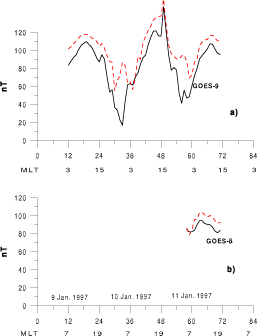
Figure 15 presents the calculations of the magnetic field along the GOES 9 and 8 spacecraft orbits. To take into account the magnetic field of the interterrestrial sources, the International Geomagnetic Reference Field (IGRF95) model was used. The agreement of calculations with the measured magnetic field confirms the initial assumptions of the relative roles of the magnetospheric current systems in the course of magnetic storm. The usage of the paraboloid model allows one to make an important physical conclusions about the development of the different magnetospheric magnetic field sources during disturbances. We can see that during the main phase of a weak magnetic storm the magnetotail current and the ring current create disturbances of approximately equal intensities. The paraboloid model describes well the magnetic field variations on the Earth's surface and at the geosynchronous orbit during the interaction of a solar wind plasma cloud with the magnetosphere on January 9-12, 1997. The root mean square deviation between the model calculations and the measured field is equal to 8.7 nT. The tail current contribution to the storm maximum disturbance is about -60 nT (for the Dst maximum equal to -78 nT).
Alexeev, I. I., Regular magnetic field in the Earth's magnetosphere, Geomagn. Aeron., Engl. Transl., 18, 447, 1978. Alexeev, I. I., E. S. Belenkaya, and C. R. Clauer, A model of region 1 field-aligned currents dependent on ionospheric conductivity and solar wind parameters, J. Geophys. Res., 105, 21,119, 2000. Alexeev, I. I., and S. Y. Bobrovnikov, Tail current sheet dynamics during substorm (in Russian), Geomagn. Aeron., 37, 5, 24, 1997. Faierfield et al., A large magnetosphere magnetic field database, J. Geophys. Res., 99, 11,319, 1994. Reeves et al., The relativistic electron response at geosynchronous orbit during the January 1997 magnetic storm, J. Geophys. Res., 103, 17,559, 1998. Tsyganenko, N.A., Modeling the Earth's magnetospheric magnetic field confined within a realistic magnetopause, J. Geophys. Res., 100, 5599, 1995. Turner, N. E., D. N. Baker, T. I. Pulkkinen, and R. L. McPherron, Evaluation of the tail current contribution to Dst, J. Geophys. Res., 105, 5431, 2000. |
| <<<'Main Page |
|
Copyright ©
2001 Laboratory of Computational Mathematics Skobeltsyn Institute of Nuclear Physics, Moscow State University |
Last updated on 19 October 2001 VK |